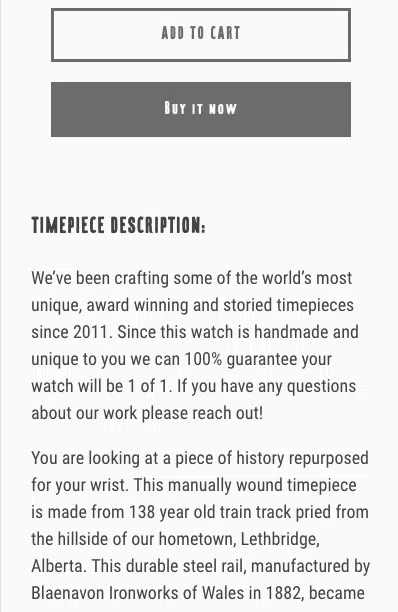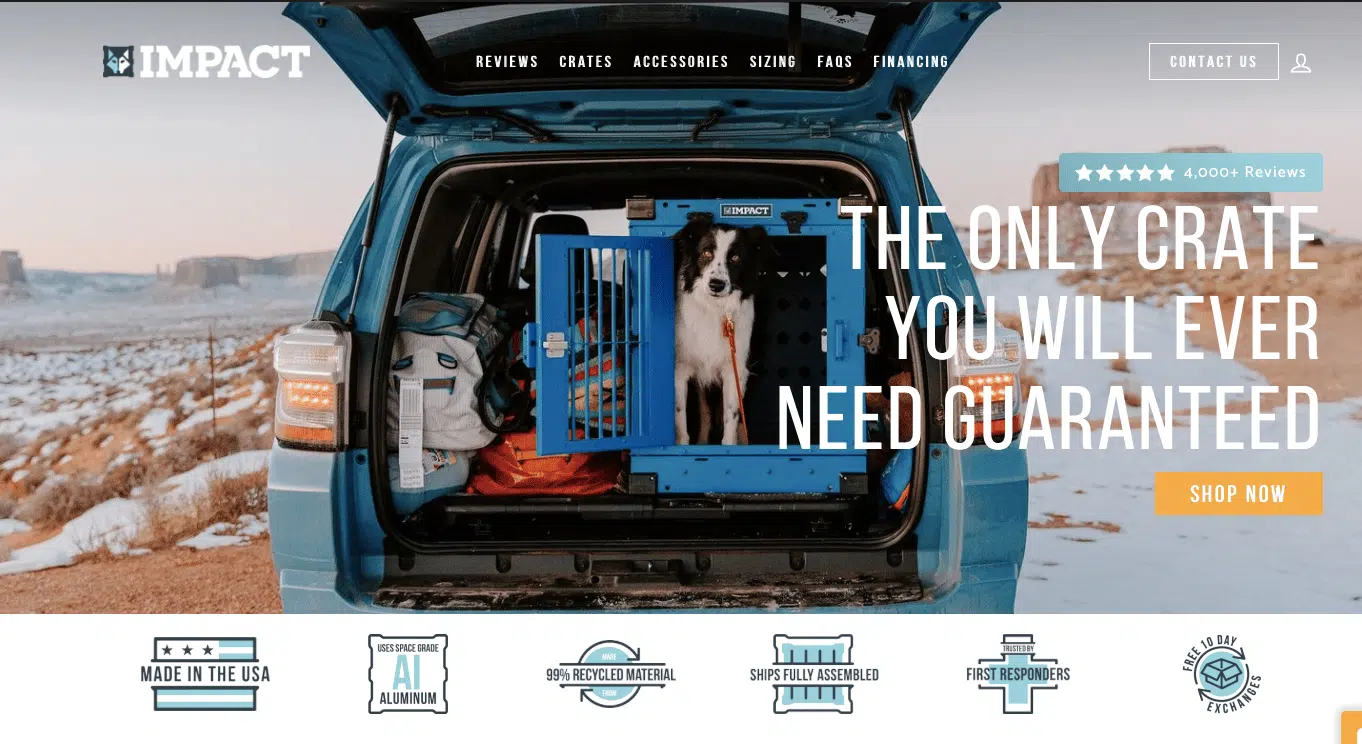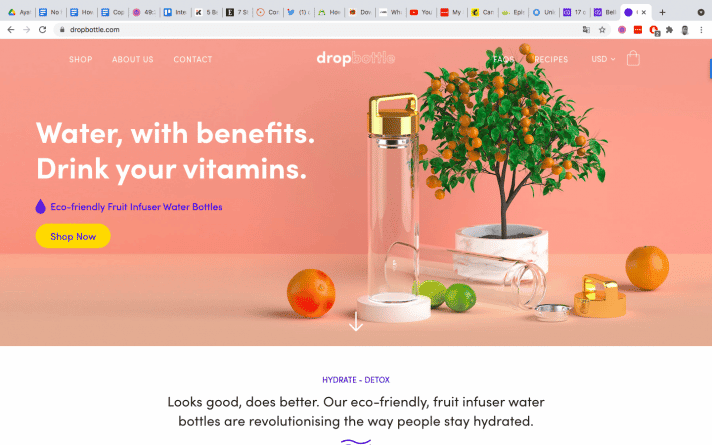I have a quick exercise for you.
Go on Google and search for your product(s).
Chances are, you will see dozens if not thousands of options that your potential customers could choose from.
Some of these options are substandard. Some of them are just as good as yours. And, if you are, to be honest, some might even be better than yours.
Now. Ask yourself these two questions:
Why should people buy from my e-commerce website?
What’s the reason they should go with us and not our competitors?
You probably have answers to these questions. But are those answers well articulated on your website?
Over the years of working with e-commerce companies of different shapes and sizes, we have noticed that most of them struggle to communicate the value they provide on their website.
Having a well-designed website, a visible and well-positioned CTAs, and a smooth checkout process is good but still not enough to convince a stranger to buy from you.
What matters the most to customers is the value they get from your product(s). If your value proposition is not solid, I can confidently say that your e-Commerce business is leaking money.
Value Proposition Definition
In short, a value proposition is a summary that articulates the value your product(s) bring to the table. It clearly states the benefits that customers will enjoy after they purchase your product.
After reading your value proposition, your audience should understand what your business is about.
Besides homepages, the other places you can insert your value propositions are the common entrances that visitors use. So it can be on landing pages, product pages, blog posts, category pages, etcetera.
When you land on the Novo Watch homepage, you will see this value proposition: “Custom watches made from meaningful memorabilia.”

When you go to their product pages, you will also notice that they reiterate their value proposition on those pages:

If you go through the product description, you will immediately realize the continuity from the homepage to the product page. I mean, phrases like “a piece of history” and “138-year-old train track” relate to the value proposition that talks about memorability.
You can also use them on Google and Facebook ads. Here’s an example, from Zola, of what a value proposition looks like on the website homepage:

Here’s is an example of how the value proposition of the same website looks like on Facebook ads:

It’s easy to understand what Zola (the above example) is all about when you read their value proposition either on their website or Facebook ads. Always cut to the chase.
With that example in mind, it’s essential to always remember that a killer value proposition doesn’t have to be too long. It doesn’t have to use technical terms as they may confuse the visitors.
In short, best value propositions need to:
- State a clear and easy-to-understand message.
- Indicate the exact value your business provides.
- Be targeted to a specific audience – if you try to speak to everyone, no one will hear you.
- Have a clear promise that is aligned with the benefits of using your product.
When it comes to the composition of a value proposition, most people believe that it has to be a one-statement headline. But that couldn’t be further from the truth. Your headline, subheadline, and even visuals can also be used to communicate your value proposition.
The visual that supports your value proposition could be a product you are providing, or sometimes it could be that buyer persona you are targeting.
Going back to that Zola example above, they used their target buyer personas (couples) as a visual that supports their value proposition.
Now that you have an idea of what a value proposition is let’s talk about placement. Should it always be on the homepage and above the fold?
Here’s the thing, it takes a few seconds for visitors to make a first impression of your brand once they land on your site. You want your value proposition to be the first thing that they see once they open your site so that they can know if they are at the right place or not.
Differences between a value proposition, a catchphrase, a USP, and a mission statement
People often confuse a value proposition with a unique selling proposition, slogan, or mission statement. Yes, they may all be related and feed into each other, but they are not the same.
So how do they differ?
Well, the best way to understand their differences is by looking at their definitions:
Catchphrase – Also known as a slogan, a catchphrase is a group of words used to convey the brand’s spirit and personality in one statement. Sephora’s “Let’s Beauty Together” is one of the most common slogans in the e-Commerce space:

Another excellent example of a common catchphrase is McDonald’s “I’m loving it.”

USP – USP is an abbreviation for a unique selling proposition that refers to a specific unique feature of your e-Commerce shop. A USP can also be part of your value proposition regarding the outstanding value it brings to the table.
ALSO READ: How to develop a unique selling proposition
Think of Impact Dog Crates, for instance; rather than telling their customers that their crates are suitable for any dog breed, they differentiate themself by promising that their products will last a lifetime or your money back:

Mission Statement: Think of it as a guideline by which a business operates. A mission statement is an action-based statement or philosophy that declares a brand’s purpose and how they serve their customers. It provides perfect clarity behind the what, the who, and the why of your business. For instance, Amazon’s mission statement is: “To keep commerce human.“
How many value propositions can a company have?
One product can be used differently. Therefore, it can be sold to different markets. So, yes, a company can have more than one value proposition.
For instance, the ultimate purpose of a laptop in a university student’s hands is completely different from in the hands of a company executive.
You may promote laptops to university students to work on their academic assignments and then offer the same laptop to a business person so that they can document their essential information for a long time.
Same product, different customer value propositions.
Again, suppose you are selling multiple products this also means that you will have various value propositions on every entry point that your visitors use. It can either be in your product pages, landing pages, and category pages.
How to write a value proposition for e-Commerce websites
A good value proposition emanates from what you do better than your competitors. But that value has to be explained in a way that is appealing to your target audience. In other words, the wording is also essential.
We have come across companies with good products, but their conversion rates were being sabotaged by their value proposition.
So, before you create a value proposition, it’s always important to do some research. This research can be guided by the four main questions listed below:
1. What problem does your product solve?
You already have a product(s), right? What customer pain points does your product solve?
You can’t define a solution without understanding the problem first. The problem that your product solves has to emanate from the customer’s pain point. Without a customer pain point, then there’s no solution. And without a solution, then there’s no product. It’s as simple as that.
If you do not point out the solution that your product offers, whatever you are saying sounds like blah, blah, and blah to every potential customer who lands on your website.
Another way of expressing the solution you are offering is to make use of statistics and specific numbers. For instance, if the product you are offering helps customers save a certain number of hours in a week or month, say it.
If you can also show your potential customers how you solve the problem they have, your value proposition can be compelling. Video demonstrations, imagery, and bullet points that list all the different ways you can use your product also help convert.
2. Who is your target audience?
My target audience, I mean the specific group of people most likely to want your product. The target audience may vary depending on interests, gender, location, age, and sometimes even income.
Let’s take a look at Dropbottle’s value proposition:

Looking at the above image, who do you think is Dropbottle’s target audience?
Well, it’s easy to tell that Dropbottle’s target audience is people who are conscious about their health and the environment. You get that kind of a vibe from reading their headline and the subheading.
And, depending on what you are selling, your target audience might be broad or niche. For instance, if you are selling travel bags, your target audience would be broad – since both men and women use them. On the other hand, perhaps you specifically sell sports bags. Then, your target audience would be a bit niche – athletes between the ages of 18 to 40.
Spend much time analyzing the data you already have from consumer engagements, purchase trends, and evaluate your current customers to determine your target audience.
The following seven steps will help you realize your target audience:
- Go through your customer base and conduct Jobs-to-be-done Interviews.
- Conduct market research and identify industry trends.
- Analyze competitors.
- Create Personas.
- Define who your target audience isn’t.
- Continuously revise.
- Use Google Analytics to view the channels your target audience is coming from.
3. What makes you different from alternatives?
This is where the unique selling point comes into play.
According to Anthony Iannarino:
“If you can’t answer the question (what makes you different?), answering the question (why should I choose you?) will be even more difficult.”
If you don’t know your competitors in and out, then there’s no way you can understand what makes you different.
So, how do you know your competitors?
You conduct a competitive analysis and figure out areas that your competitors lack and use their weaknesses to your advantage. You can go through your competitors’ websites and marketing campaigns to explore their weaknesses.
There are many angles you can use to position yourself differently from your competitors. My favorites are brand stories, values, or even beliefs because they are difficult for competitors to replicate.
Features can also be used as differentiators, but the problem is that they can be easily copied. So is the price.
Conclusion: Be simplistic
Using vague languages or industry jargon will not make your value proposition compelling nor make you sound knowledgeable. Tied phrases like we are “customer-centric” or “results-driven” are not specific enough, and they can be said just by anyone – even your competitors. Best e-Commerce value propositions are simple, and they use straightforward language that can be understood without one having to pull out a dictionary.



